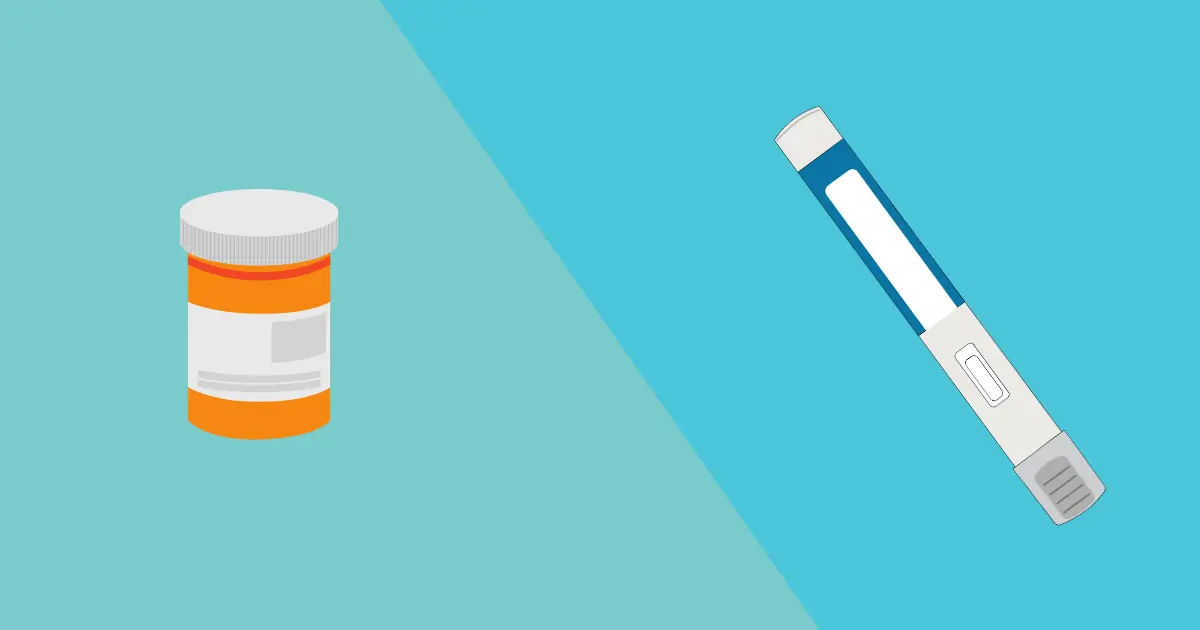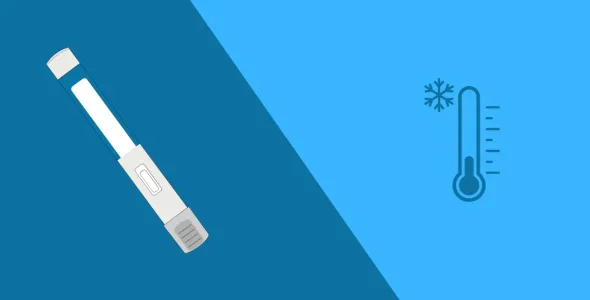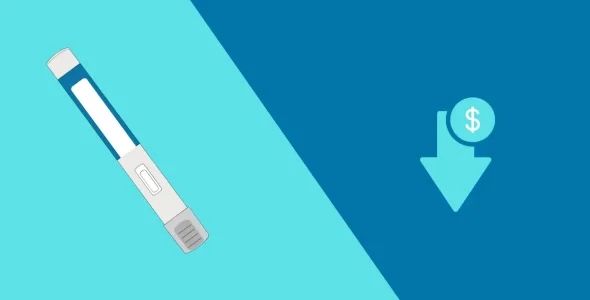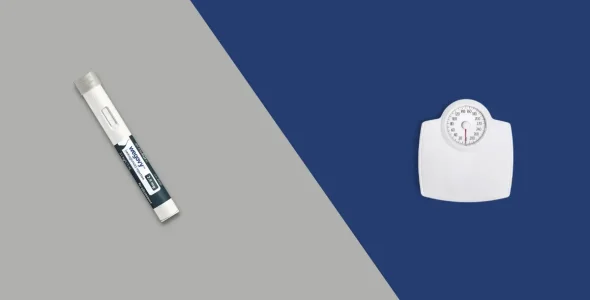Contrave vs. Wegovy for weight loss
Prescription weight loss medications like Contrave and Wegovy are in high demand, but which one is right for you? Discover the key differences from side effects to long-term success rates that could save you time, money, and frustration.
Key highlights
- Contrave and Wegovy are prescription weight loss medicines for adults with obesity, overweight, or other weight-related health conditions.
- Contrave is an oral medication made of two medicines called bupropion and naltrexone. Wegovy is a weekly injectable medicine that contains semaglutide.
- Wegovy is approved for both adults and children 12 years and older. It's also approved to help lower the risk of heart problems in adults who have heart disease and are overweight or obese. Contrave, however, is only approved for weight loss in adults.
- Clinical trials have shown that Wegovy works better than Contrave for weight loss. However, both medicines can help with weight loss. They have different side effects and may interact with other medications, so the best choice depends on your health and what works best for you.
- Both medicines can cause similar side effects, but Wegovy may lead to more stomach problems. Whereas, Contrave might affect the liver and raise blood pressure.
Being overweight can lead to serious health problems, with many people looking for help beyond diet and exercise. Contrave (naltrexone/bupropion) and Wegovy (semaglutide) are prescription drugs that can help adults manage their weight. They are approved for people who are obese or overweight and have at least one health issue related to weight, such as high blood pressure or Type 2 diabetes.
GLP-1 agonists like Wegovy are becoming more popular than traditional appetite suppressants like Contrave. This is because GLP-1 drugs often lead to more weight loss and also help with blood sugar control, making them a preferred choice for many people and healthcare providers.
Choosing the right weight-loss medication can be complex, as it depends on each person’s health needs, medical history, and how their body responds to treatment. Contrave and Wegovy are often compared because they work in different ways, and people want to know which one might be safer or more effective for them.
Read on to learn more about the key differences between Contrave and Wegovy, including their mechanism of action, side effects, and expected weight loss.
What are Contrave and Wegovy?
Contrave and Wegovy are FDA-approved prescription medications used to help with long-term weight management in people who are overweight or have obesity.
Contrave (naltrexone HCl/bupropion HCl extended-release)
Contrave is a prescription medicine that combines two active ingredients: bupropion and naltrexone. Bupropion is often used to treat depression and help people stop smoking, while naltrexone is used to treat alcohol and drug addiction.
Naltrexone belongs to a class of drugs called opioid antagonists, which block opioid receptors in the brain to reduce food cravings and the reward response to eating.
Bupropion belongs to a class of atypical antidepressants and is also used as a smoking cessation aid. It works by affecting brain chemicals like dopamine and norepinephrine, which can help reduce appetite.
Together, these medicines help reduce hunger and control cravings by working on parts of the brain that regulate appetite. Contrave comes as a long-acting tablet, usually taken twice a day, in the morning and evening.
Wegovy (semaglutide)
Wegovy was approved by the FDA for chronic weight management in adults and adolescents with obesity or overweight with at least one weight-related condition, such as high blood pressure, type 2 diabetes, or high cholesterol. It was also approved in 2024 for reducing the risk of serious heart problems in adults with obesity or overweight.
Semaglutide belongs to a class of drugs called glucagon-like peptide-1 (GLP-1) receptor agonists known for their dual benefits: helping to control blood sugar levels in adults with type 2 diabetes and supporting weight loss in people with or without diabetes when used in combination with diet and increased physical activity.
Semaglutide works for weight loss by mimicking the action of incretin, a natural gut hormone, particularly GLP-1, and targeting GLP-1 receptors in the brain that control appetite and slow down how quickly the stomach empties, making you feel fuller for longer. By increasing GLP-1 activity, semaglutide helps to reduce hunger and suppress appetite.
Prescribers typically start patients at 0.25 mg once weekly for 4 weeks and increase the dose until a full dose of 2.4 mg is reached. The maximum maintenance dose of Wegovy is 2.4 mg once weekly.
How do Contrave and Wegovy work?
Wegovy and Contrave both help with weight loss, but they work in different ways:
Contrave’s mechanism
Contrave helps with weight loss by targeting areas in the brain that control hunger and cravings. It combines two medicines:
Naltrexone locks brain signals linked to food cravings and affects the “reward center” in the brain that controls pleasurable activities, like eating.
Bupropion is an antidepressant that can reduce appetite and may help your body burn more energy.
It works on the part of your brain that controls pleasure, like eating, to help reduce food cravings. It may also help you feel less hungry and burn more calories.
Wegovy’s mechanism
Wegovy can lead to significant weight loss in people with excess weight and obesity when used with lifestyle changes.
In a 68-week clinical trial, participants on Wegovy lost an average of 14.9% body weight compared to 2.4% in the placebo group.
Semaglutide works by mimicking the GLP-1 receptor, a natural hormone that releases insulin, reduces glucagon, and controls appetite, so you eat less. Together, these effects make it easier to lose weight when used with a healthy diet and exercise.
Semaglutide lowers blood sugar by reducing glucagon production, a hormone produced by the pancreas that tells the liver to release stored sugar into the blood, which raises blood sugar levels.
By suppressing glucagon, semaglutide prevents the liver from releasing too much sugar and keeps blood sugar more stable after eating.
This helps with blood sugar control and weight loss by stopping the body from storing excess sugar as fat, creating a better environment for burning fat and losing weight.
Semaglutide helps with weight loss by slowing down how fast food moves through the stomach and into the intestine, also known as gastric emptying. This means you feel full and less hungry for longer, and eat less or snack less between meals.
Semaglutide works by targeting the GLP-1 receptors in the brain to reduce food cravings and increase fullness. By targeting these brain signals, semaglutide controls hunger and satiety.
This makes you less hungry and more full after eating, so you eat less and are less likely to give in to food cravings, which can support weight loss.
Semaglutide lowers calorie intake by making you feel full for longer and reduces your food intake. By acting on the brain to increase satiety and slow down gastric emptying, it controls your appetite, so you eat fewer calories.
Key differences
The biggest difference between Contrave and Wegovy is how they work in the body.
Contrave works on brain chemistry. It targets areas in the brain that control appetite and cravings using two medications: bupropion (an antidepressant) and naltrexone (used to reduce cravings).
Wegovy mimics a natural gut hormone called GLP-1. This helps you feel full longer, reduces appetite, slows digestion, and may quiet “food noise” (constant thoughts about eating).
Contrave is available as an extended-release oral tablet, while Wegovy is available as a weekly subcutaneous injection.
Contrave vs. Wegovy: Effectiveness for weight loss
Wegovy and Contrave have both helped people lose weight in studies and worked better than a placebo. However, Wegovy may help people lose more weight than Contrave.
Clinical results for Contrave
In the 56-week COR-I study, people with a BMI of 27 or more took Contrave (a mix of naltrexone and bupropion). They lost about 4.8% more weight on average than those who took a fake pill (placebo). Also, 48% of people on Contrave lost at least 5% of their body weight, while only 16% of those on the placebo did.
In another study, people taking Contrave lost an average of 5–10% of their body weight over 12 months when the medicine was combined with a healthy diet and regular exercise.
Contrave works best when used along with lifestyle changes like eating fewer calories and being more active.
Clinical results for Wegovy
The STEP 1 study looked at how Wegovy works in people with a BMI of 27 or higher. It found that people taking Wegovy lost about 12.4% more weight than those who took a placebo (a fake treatment). Also, 86.4% of people on Wegovy lost at least 5% of their body weight, compared to only 31.5% in the placebo group.
Another study showed that people taking Wegovy lost an average of 15–20% of their body weight in clinical studies, especially when combined with healthy eating and exercise.
Wegovy has shown stronger weight loss results than many other weight-loss medications.
Head-to-head comparison
There aren’t any direct studies comparing Wegovy and Contrave. It’s best to talk to a healthcare professional, who can look at your health and needs to help choose the right treatment for you.
Side effects: Contrave vs. Wegovy
While both Contrave and Wegovy share some similar side effects, like nausea, headache, dizziness, and constipation, they also have key differences.
Common side effects
The most common side effects of Contrave include nausea, constipation, headache, dizziness, trouble sleeping, anxiety, shaking, and dry mouth. Wegovy has some of the same side effects, like headache, nausea, dizziness, and constipation.
However, Wegovy may cause more stomach-related problems, such as nausea, diarrhea, upset stomach, and stomach pain, compared to Contrave.
Rare side effects
Serious side effects can happen with both Contrave and Wegovy. Both medicines may cause serious allergic reactions, low blood sugar, and a faster heart rate.
Contrave can also lead to:
- Seizures (especially with high-fat meals or certain pre-existing conditions)
- Liver problems
- Vision changes
Rare and serious Wegovy side effects may include:
- Pancreatitis (inflammation of the pancreas)
- Gallbladder problems
- Thyroid tumors (including cancer in rare cases)
- Kidney problems
Boxed warnings
Both Contrave and Wegovy come with important safety warnings, including the risk of suicidal thoughts and behavior.
Contrave specifically highlights this risk in children, teenagers, and young adults, while Wegovy recommends monitoring all users for signs of depression or suicidal thoughts. Contrave may also cause serious mental health side effects such as psychosis, hallucinations, and paranoia. Other risks linked to Contrave include seizures, liver problems, angle-closure glaucoma (a serious eye condition), and increases in blood pressure or heart rate.
Wegovy, on the other hand, carries warnings for pancreatitis (inflammation of the pancreas), gallbladder disease, acute kidney injury, eye complications related to diabetes (diabetic retinopathy), and increased heart rate.
Neither medication is recommended during pregnancy or while breastfeeding. If you are pregnant, planning to become pregnant, or breastfeeding, it’s important to speak with your doctor about safer treatment options.
Which has fewer side effects?
Both Contrave and Wegovy have potential side effects, but they tend to affect the body in different ways. Contrave is more likely to cause mood-related side effects, such as anxiety, insomnia, and, in rare cases, hallucinations or paranoia. Wegovy, on the other hand, more commonly causes gastrointestinal (GI) issues like nausea, vomiting, diarrhea, and stomach pain.
While neither medication is free of side effects, the type of side effects differs. The “better” option depends on your health history and how your body responds. Your doctor can help decide which is more suitable for you.
How to manage side effects?
Managing side effects from Contrave or Wegovy often starts with a gradual dosing schedule, which helps your body adjust and reduces the chances of early side effects like nausea or dizziness. Making small dietary changes can also help. Eating bland foods (like toast or crackers) may ease nausea, while adding more fiber and water can help with constipation.
Most importantly, always talk to your doctor if side effects are severe or don’t go away. They may adjust your dose, suggest remedies, or explore other treatment options to keep you comfortable and safe.
Eligibility and special considerations
Contrave is approved by the FDA for weight loss in adults only. Wegovy is approved for weight loss in adults and in children 12 and older who have obesity. Wegovy is also approved to help lower the risk of heart attacks, strokes, and other heart problems in people who are overweight or have obesity and also have heart disease.
Neither Contrave nor Wegovy is a cure for obesity or other health problems. But they can help with weight loss when used along with healthy eating, regular exercise, and other lifestyle changes.
General eligibility
Contrave and Wegovy are medicines used to help adults manage their weight over the long term. They are given to people who are obese or overweight and have a health problem related to their weight, like high blood pressure, high cholesterol, or Type 2 diabetes.
Both Contrave and Wegovy are indicated for individuals with:
- A BMI of 30 or more (obesity)
- A BMI of 27 or more (overweight) with at least one weight-related comorbidity (e.g., high blood pressure, high cholesterol, type 2 diabetes)
Contraindications
Contrave is not approved for children and should be avoided in certain health conditions. It is not safe for people who have:
- A seizure disorder or a history of seizures
- A history of anorexia or bulimia
- Opioid dependence or have recently used opioids
- Uncontrolled high blood pressure
- A history of suicidal thoughts or actions
- Are taking MAO inhibitors (certain antidepressants)
If you have any of these conditions, talk to your doctor before starting Contrave, as it could increase the risk of serious side effects.
You should not use Wegovy if you:
- Are allergic to semaglutide or any of the ingredients.
- Have a personal or family history of medullary thyroid cancer or medullary thyroid carcinoma (MTC) or Multiple Endocrine Neoplasia syndrome type 2 (MEN 2).
- Are pregnant or planning to become pregnant.
- Are breastfeeding, as it is not known if Wegovy passes into breast milk.
- Have a severe gastrointestinal disease, such as gastroparesis (delayed stomach emptying).
- Have diabetic ketoacidosis (a serious complication of diabetes).
Some people may have a higher risk of side effects when using Wegovy due to their medical history or current health conditions. Here’s a simple breakdown of who might be more at risk:
- People with pre-existing gastrointestinal conditions: Wegovy slows digestion, which can worsen symptoms in people with IBS, reflux, gastroenteritis, gastroparesis, or other GI disorders.
- Individuals with type 2 diabetes (for hypoglycemia and retinopathy): Wegovy can lower blood sugar, especially when combined with insulin or other diabetes drugs.
- Those with a personal or family history of thyroid cancer or MEN2: Wegovy have a warning for these rare cancers based on animal studies. It’s not recommended for people with this history.
- People with kidney disease or gallstones: Side effects like vomiting or diarrhea can cause fluid loss, which puts extra strain on the kidneys.
- Older adults (75 and older): Aging bodies may process drugs more slowly and are more sensitive to side effects.
- Individuals with a history of depression or suicidal thoughts: While rare, some people report changes in mood while on Wegovy. Anyone with a mental health history should be closely monitored.
Wegovy should not be used with other weight loss interventions or GLP-1 receptor agonists (Ozempic, Mounjaro, or Zepbound), as this may increase the risk of side effects. Always inform your healthcare provider about all over-the-counter medications or supplements you are taking.
Additional benefits with Wegovy
Wegovy offers more than just weight loss; its benefits extend to various aspects of health and well-being, especially for individuals with obesity or weight-related conditions.
- Significant and sustained weight loss: Clinical trials show that adults taking Wegovy lost an average of 15% of their body weight, and adolescents lost ~16% on average when combined with lifestyle changes.
- Improvements in weight-related health conditions: Wegovy may help lower blood pressure, cholesterol levels, and blood sugar, reducing the risk of developing or worsening chronic diseases like type 2 diabetes.
- Reduced cardiovascular risk: In eligible adults with obesity and heart disease, Wegovy has been shown to lower the risk of major cardiovascular events such as heart attack and stroke.
- Improved quality of life: Many patients report better physical mobility, improved energy levels, and enhanced self-esteem while using Wegovy.
- Appetite control and reduced cravings: Wegovy helps regulate appetite hormones, making it easier to manage hunger and reduce overeating.
- Approved for adolescents (12+ years): Wegovy is FDA-approved for weight management in teens, addressing a growing and underserved need in adolescent obesity care.
Cost and insurance coverage
Both Contrave and Wegovy are brand-name drugs and can be very expensive if you’re paying out of pocket.
There are currently no generic forms of either medication, which is one reason why the prices are so high.
Some insurance plans may cover one or both, but coverage often depends on your medical history and the plan’s rules. It’s best to check with your provider.
Contrave cost
Contrave can cost $500 to $700+ per month, and often up to $840–$830 for a 30-day supply (120 tablets).
Currax Pharmaceuticals LLC, the manufacturer, offers Contrave for $99 or less per month (with free mail delivery) for eligible patients, including uninsured, Medicaid, Medicare Part D, or TRICARE beneficiaries.
For insured patients, out-of-pocket costs may be as low as $20 per month. For those uninsured or whose insurance doesn’t cover it, the coupon caps the price at $199 per month.
Wegovy cost
The list price of Wegovy is $1,349.02 per month, according to the manufacturer, Novo Nordisk, which is about $337.30 per week or $16,188.20 per year.
Check with your insurance provider if they cover Wegovy. Most insurance plans, including Medicare and Medicaid, do not currently cover weight loss drugs.
The Wegovy Savings Card program helps you save money with or without insurance to reduce your out-of-pocket cost of Wegovy to as low as $0/month, making the medication more affordable for eligible individuals.
The program is available to those with commercial insurance or without insurance coverage and excludes those with government-sponsored insurance like Medicare and Medicaid.
To qualify for the Wegovy Savings Card, you must meet certain criteria. If you qualify for the savings card, you can also join WeGoTogether for free. This program offers personalized support to help with weight loss and maintenance, including a health coach, a progress-tracking portal, and more.
Insurance coverage
Many health insurance plans do not cover weight loss medications, or they may have strict rules.
It’s important to look at your insurance formulary (the list of covered drugs) to see if Contrave or Wegovy is included.
Even if covered, your doctor may need to submit a prior authorization or proof that the drug is medically necessary.
Your deductible and copay can affect how much you pay each month, even if the drug is covered.
Most Medicare plans do not cover weight loss medications, unless the drug is approved for another condition, like diabetes.
Always call your insurance provider or check their website to confirm coverage and requirements before starting either medication.
Key considerations when choosing between Contrave and Wegovy
When deciding between Contrave and Wegovy, it’s important to consider several key factors:
Administration preference
When choosing between Contrave and Wegovy, how you take them is an important factor.
Wegovy is a shot you give yourself once a week. It comes in a prefilled pen and is injected under the skin, usually in your stomach, thigh, or upper arm. You can do it at home, but if you don’t like needles, Wegovy might not be right for you.
Contrave is a pill you take by mouth. After the first week, you usually take 2 tablets, twice a day. You can take it with or without food, but not with a high-fat meal, as that can make your body absorb too much medicine. The tablets must be swallowed whole; don’t crush or chew them, so if you have trouble swallowing pills, keep that in mind.
Medical history and co-existing medical conditions
Your medical history plays a big role in choosing between Contrave and Wegovy. Wegovy is generally safer for people with heart disease and is also helpful for those with type 2 diabetes, as it improves blood sugar and reduces heart risks.
Contrave should be avoided if you have a history of seizures, as it can increase seizure risk, or glaucoma, due to potential eye pressure issues. For those with mental health conditions like depression or binge eating, Contrave may help, but it can also cause mood changes, so careful monitoring is needed.
Neither drug is safe during pregnancy or breastfeeding. Always talk to your doctor to choose the best option based on your health.
Side effect profile
When choosing between Wegovy and Contrave, think about which side effects concern you most and how you might handle them.
If you’re worried about stomach issues like nausea, bloating, or diarrhea, know that these are more common with Wegovy, especially in the first few weeks. These side effects often improve over time and can be managed with gradual dose increases, eating bland foods, and staying well-hydrated.
If you’re more concerned about mood changes, insomnia, or anxiety, these are more likely with Contrave, since it affects brain chemicals. It’s important to let your doctor know if you have a history of mental health conditions, so they can monitor you closely or adjust your treatment.
Age
Age matters when choosing a weight-loss medication. Wegovy is approved for both adults and teens aged 12 and older, making it an option for adolescents with obesity. Contrave, however, is approved only for adults 18 and older.
Cost and insurance coverage
Contrave and Wegovy are only sold as brand-name drugs, which can make them expensive. Fortunately, there are ways to save money by using the manufacturer’s savings card programs.
- Save on Wegovy: You may pay as little as $0 per month with a savings card from the maker. If your insurance doesn’t cover it, other discounts may be available to lower the cost.
- Save on Contrave: With insurance, you could pay as little as $20 per month using a copay card. If you don’t have insurance or your plan doesn’t cover it, you might qualify for an access program that gives you a month’s supply for $99 or less.
Long-term goals
Wegovy and Contrave haven’t been directly compared in a single study, but separate studies suggest Wegovy may lead to more weight loss.
- Contrave helped people lose about 8% of their body weight after 56 weeks. With extra diet and exercise support, that went up to over 11%.
- Wegovy led to an average weight loss of about 15% after 68 weeks.
Both medicines can help with weight loss, but results vary from person to person. Your doctor will help choose the best option based on your health and goals.
Can I switch?
Yes, switching is possible, but it should only be done under a doctor’s guidance. Your healthcare provider may recommend slowly tapering off one medication before starting the other to reduce the risk of side effects or drug interactions. Never switch or stop medications on your own without medical advice.
Who should choose Contrave?
The FDA has approved Contrave for long-term weight management in adults who meet specific BMI requirements:
- A body mass index (BMI) of 30 kg/m² or higher (obese), or
- A BMI of 27 kg/m² or higher (overweight), plus at least one weight-related medical condition, such as high blood pressure, type 2 diabetes, or high cholesterol (dyslipidemia)
Contrave can also be taken by:
- Adults looking for mild to moderate weight loss
- People who also have depression or binge eating disorder, Contrave may help with mood and cravings
- Those who prefer taking a daily pill instead of weekly injections
- Only approved for use in adults (18 and older)
If you prefer tablets over injections or do not require significant weight loss (above 10%), Contrave may be right for you.
Contrave is a daily pill for adults with obesity or overweight and related conditions. It’s ideal for those wanting moderate weight loss (around 5–9% of body weight), especially if they struggle with cravings or mood-related eating. It’s not suitable for people with seizure disorders or those using opioids.
Choose Contrave if you prefer pills and mild weight loss.
Who should choose Wegovy?
The FDA has approved Wegovy for chronic weight management in adults with:
- Obesity: body mass index (BMI) of 30 or higher, or;
- Overweight: BMI of 27 or higher with at least one weight-related health condition, like type 2 diabetes, high blood pressure, or high cholesterol.
- Those who haven’t succeeded with other medications.
The FDA has also approved Wegovy for adolescents aged 12 years and older who have obesity, defined as:
- a BMI at or above the 95th percentile for age and sex, based on CDC growth charts
- Must weigh at least 60 kg (132 lbs)
- Administered as a once-weekly subcutaneous injection
- Must be used in conjunction with a reduced-calorie diet and increased physical activity
- If an adolescent does not achieve at least a 5% reduction in BMI after 12 weeks on the 2.4 mg or maximum tolerated dose, treatment should be discontinued and re-evaluated
In March 2024, the FDA approved Wegovy to reduce the risk of cardiovascular death, stroke, and heart attack in adults with cardiovascular disease and either obesity or overweight.
Additional considerations:
- Wegovy is not approved for use in children under 12 years of age.
- It is not recommended to coadminister Wegovy with other semaglutide-containing products or other GLP-1 receptor agonists.
Wegovy is a weekly injection approved for adults and teens. It leads to greater weight loss (around 15% of body weight) and is also approved to reduce the risk of heart attack and stroke in adults with heart disease. It’s not recommended for people with certain thyroid tumors.
Choose Wegovy for stronger results, for adolescents, or if heart health is a concern.
Can you take Contrave and Wegovy together?
It’s usually not a good idea to take Contrave and Wegovy at the same time. They are both used for weight loss, but work in different ways.
Taking them together could cause more side effects and might not help you lose more weight. Always talk to your healthcare provider before using more than one weight-loss medicine.
| Contrave | Wegovy | |
|---|---|---|
| Chemical name | Naltrexone/bupropion | Semaglutide |
| FDA approved indications | Weight loss (obesity/overweight) | Weight loss (obesity/overweight), cardiovascular risk reduction |
| Side effects | Nausea (32.2%), Headaches (17.7%), Constipation (12.1%), Dizziness (11.1%), Dry mouth (9.1%), Tiredness (5.9%), Anxiety (5.4%) | Nausea (32.4%), Constipation (14.8%), Vomiting (10.5%), Diarrhea (9.7%), Headaches (6.8%), Tiredness (6.6%), Heartburn (6.2%) |
| Average weight loss | 5-10% of body weight over 56 weeks | 14.9% of body weight over 68 weeks |
| Drug class | Opioid antagonist/antidepressant | GLP-1 Agonists |
| Generic availability | No lower cost generic approved yet | No lower cost generic approved yet |
| Dosage forms | Oral tablet, extended release | Subcutaneous injection |
| Standard dosage | Week 1: Take 1 tablet in the morning Week 2: Take 1 tablet in the morning and 1 in the evening Week 3: Take 2 tablets in the morning and 1 in the evening Week 4 and after: Take 2 tablets in the morning and 2 in the evening each day. | 0.25 mg injected under the skin once weekly for 4 weeks, then the dosage is gradually increased to 1.7 or 2.4 mg once weekly |
| Half-life | 21 hours | 168 hours |
| Controlled Substances Act (CSA) schedule | Not a controlled drug | Not a controlled drug |
| Who can use the medication | Adults | Adults and children 12 years and older |
FAQs
Which works faster, Contrave or Wegovy?
Wegovy typically works faster than Contrave, with some individuals experiencing weight loss within a few weeks. Contrave may take a few months to show visible results.
Which medication is more effective for weight loss?
Wegovy is generally more effective for weight loss than Contrave. People taking Wegovy often lose more weight on average compared to those taking Contrave.
Do you regain weight after stopping?
Yes, you can regain weight after stopping either medication if you don’t keep up with healthy habits. Making long-term lifestyle changes is essential to maintain weight loss.
Are generic versions available for either drug?
No, there are no generic versions of either drug available. Both Contrave and Wegovy are only sold as brand-name medications right now.
Are there natural alternatives to these drugs?
Yes, natural alternatives include lifestyle changes such as eating a healthy diet, exercising regularly, and getting sufficient sleep. Diets high in protein and fiber can help control hunger, much like GLP-1 drugs like Wegovy.
Conclusion
Contrave and Wegovy take different approaches to weight loss, each with its strengths.
Wegovy is generally more effective for weight loss and is also approved to help reduce the risk of heart problems in people with obesity or heart disease. However, it’s more expensive and requires a weekly injection.
Contrave may be a better fit for people with mild to moderate weight loss goals, those who prefer a daily pill, or individuals dealing with emotional eating or depression, as it may help curb cravings linked to brain reward signals.
The right choice depends on your individual needs, health conditions, lifestyle, and comfort level with the medication format.
No matter which option you choose, remember: both Wegovy and Contrave can be powerful tools when used correctly alongside healthy eating and activity.
Have an honest conversation with your doctor to find the best path for your weight loss journey.






